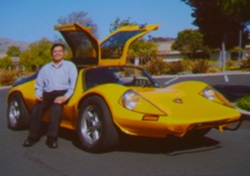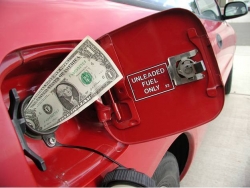 An ECM exclusive special report
An ECM exclusive special report
Amptran is developing an electric engine with capacity to travel 400 miles between charges using lithium air technology. The break-through could revolutionize the car industry --and eliminate U.S. dependence on OPEC Mideast oil
By Miriam Raftery
November 18, 2011 (Otay Mesa)—In an exclusive interview with ECM, Heartland Coalition executive director Mark Hanson unveiled plans to bring Amptran Motor Corporation to San Diego and to open a new Greensmart Technical College facility in Otay Mesa, where certified electric vehicle technicians will be trained for good-paying local jobs through Heartland’s Project Greensmart, starting in spring 2012.
“This is our long-awaited technical training facility. The students will all get jobs. There will be manufacturing right there,” Hanson revealed. The facility will also be retrofitting in-demand older cars, such as Porsches, with electric engines.
Hanson added that Heartland and Amptran are finalizing arrangements with the City of San Diego, which is offering incentives such as fee waivers to entice the innovative electric car maker to our region.
After Hanson led Amptran Motor Corporation chairman Lloyd Tran on a tour of potential sites, the company opted to open up its facilities will be located in abandoned buildings originally built for the maquiladora program.

“If the U.S. electrified half of its cars and light trucks, it would reduce petroleum consumption by 5 million barrels a day—roughly the same amount that we import from OPEC,” said Tran, who also serves as director of the CleanTech Institute in the San Francisco area. Similar electric car technician programs are already in place in Los Angeles and San Francisco.
Tran made the remarks Sunday at the Forging a Sustainable Future Conference at Qualcomm headquarters in San Diego, an event sponsored by Heartland’s United Green division.
“We normally work with redevelopment agencies and others…We need incentives to come into an area.” Tran told ECM that he looked at properties near Gillespie Field in El Cajon, but opted instead for newer facilities in Otay, where City of San Diego representatives voiced a willingness to provide the incentives needed. The deal is being finalized, with plans to open the training program as early as April.
Transportation guzzles two-thirds of the 19 billion barrels a day used by American consumers. The U.S. accounts for 20 percent of global oil demand, so reduced U.S. reliance on oil could have a huge impact on not only national security, but global climate change by dramatically reducing greenhouse gas emissions.
guzzles two-thirds of the 19 billion barrels a day used by American consumers. The U.S. accounts for 20 percent of global oil demand, so reduced U.S. reliance on oil could have a huge impact on not only national security, but global climate change by dramatically reducing greenhouse gas emissions.
Converting to a green fuels economy also has potential to create high-paying jobs across the nation, reduce or eliminate the risk of deep water oil spills such as the BP Deepwater Horizon disaster in the Gulf, and ultimately save consumers money, since fueling up at the gas pump would no longer be necessary.
Lithium air technology is enabling Amptran to develop an electric engine that will allow motorists to drive 400 miles between charges—double the current best on the market (200 miles with a Tesla electric roadster). “We are now in the proof-of-concept stage,” said Tran, who predicts his company is two to four years away from mass production.
“The internal combustion engine is only 15 percent efficient, with an 85 percent loss of heat,” Tran noted. He added that gasoline motors produce toxic exhaust that can cause respiratory diseases.

Tran emphasized that an oil-based economy is not sustainable long-term. He noted that the U.S. has made several past major shifts in fuel: in the 1890s, America transitioned from wood to coal fuels, then coal in turn was largely replaced by oil in the 1960s. “The solution is to delink our transportation system from the global oil market,” Tran concluded.
Electric vehicles are not new. The first was produced way back in 1902. But recent technological advances, fueled by federal research investment dollars, are finally making it possible for consumers who need to drive longer distances to own electric cars.
While some remain pricey (Tesla’s Roadster costs a hefty $110,000), others are now much more affordable. The Nissan Leaf, which goes 100 miles between charges, runs about $38,000 with $7,000 in tax credits available. Next year, the Mitsubishi Miev hybrid is expected to hit the market at $21,625 after tax savings. The Coda electric, which will run about $42,000 and go 150 miles, is also poised for the market.

Amptran's long-range electric car will likely hit the market in the $40,000+ range, however the company is also working to develop a lower-cost sedan. For consumers weary of rising and unpredictable gasoline prices, however, the prospect of never again having to pay to fill up at the pump has growing appeal.
President Barack Obama, in his 2011 state of the union message, has set a goal to have one million electric vehicles in the U.S marketplace by 2015.
“There is a tremendous race,” Tran said of efforts to develop electric vehicles with long ranges to both meet the President’s green transportation goal and put Americans back to work in car manufacturing jobs. He concluded, “The U.S. Department of Energy has a lot of interest in funding research to take this away from the Japanese.”
Heartland Coalition, a 501c3 nonprofit, is also the publisher of East County Magazine.











Recent comments